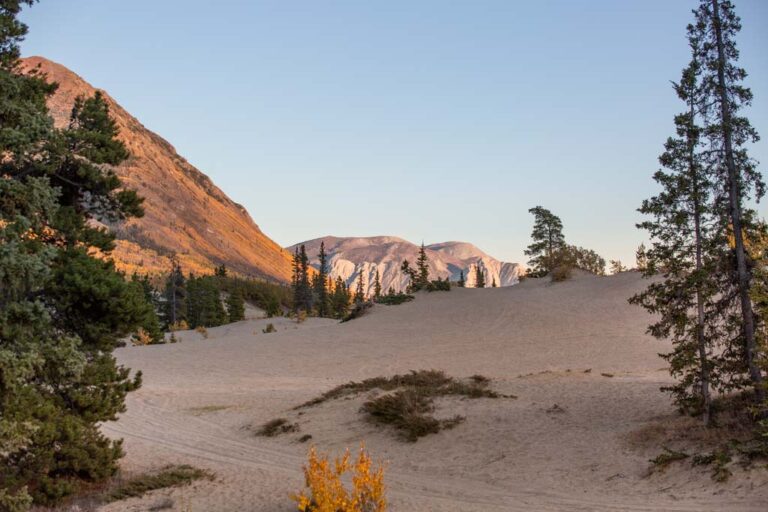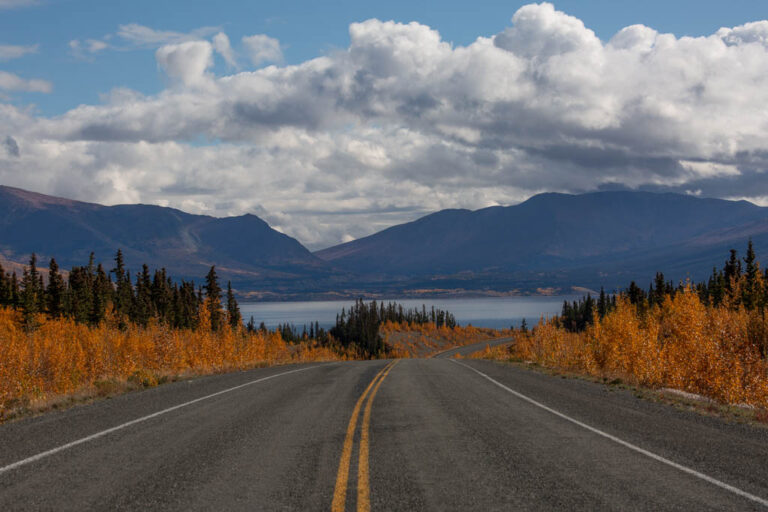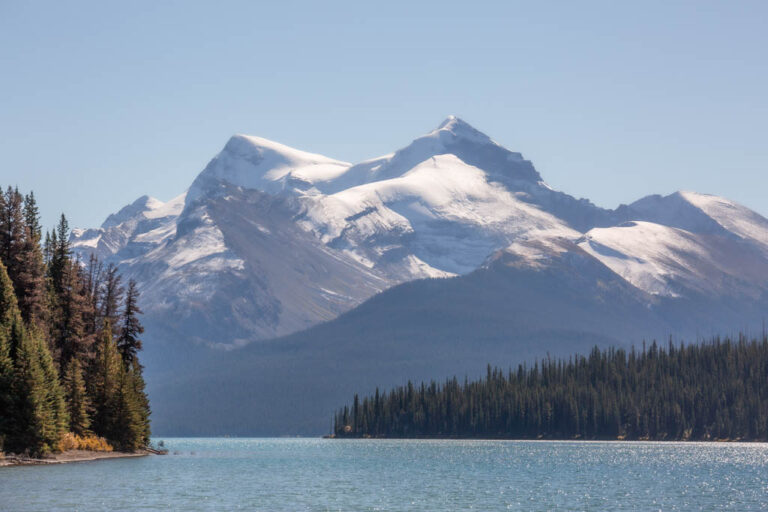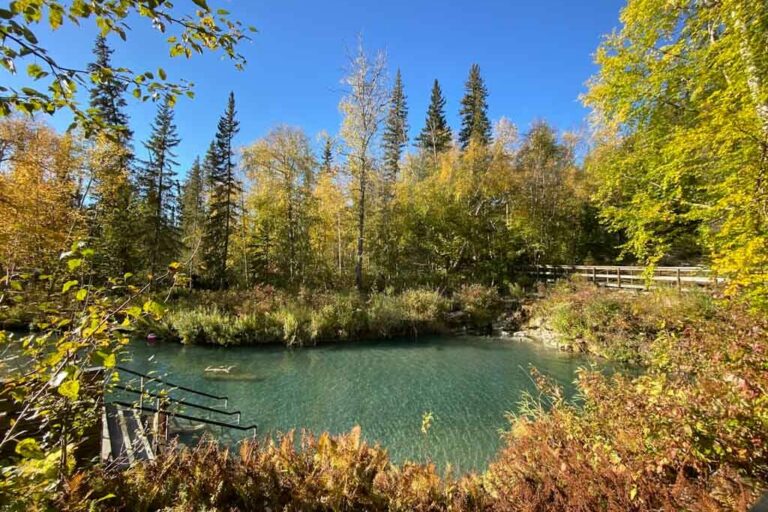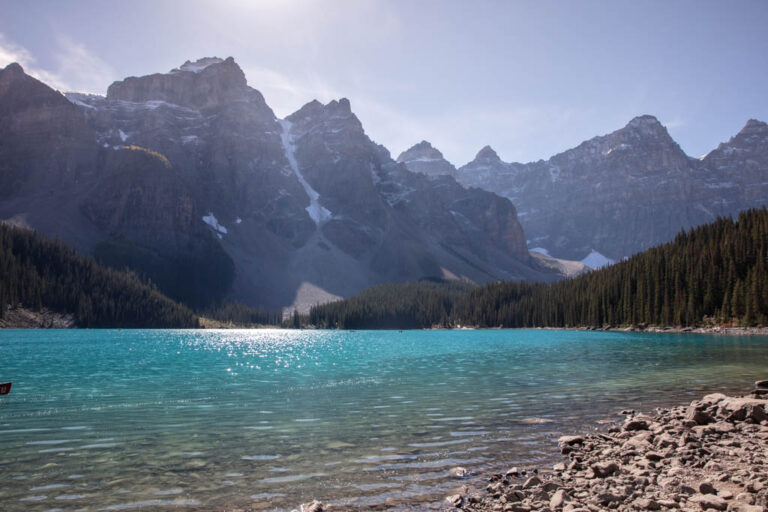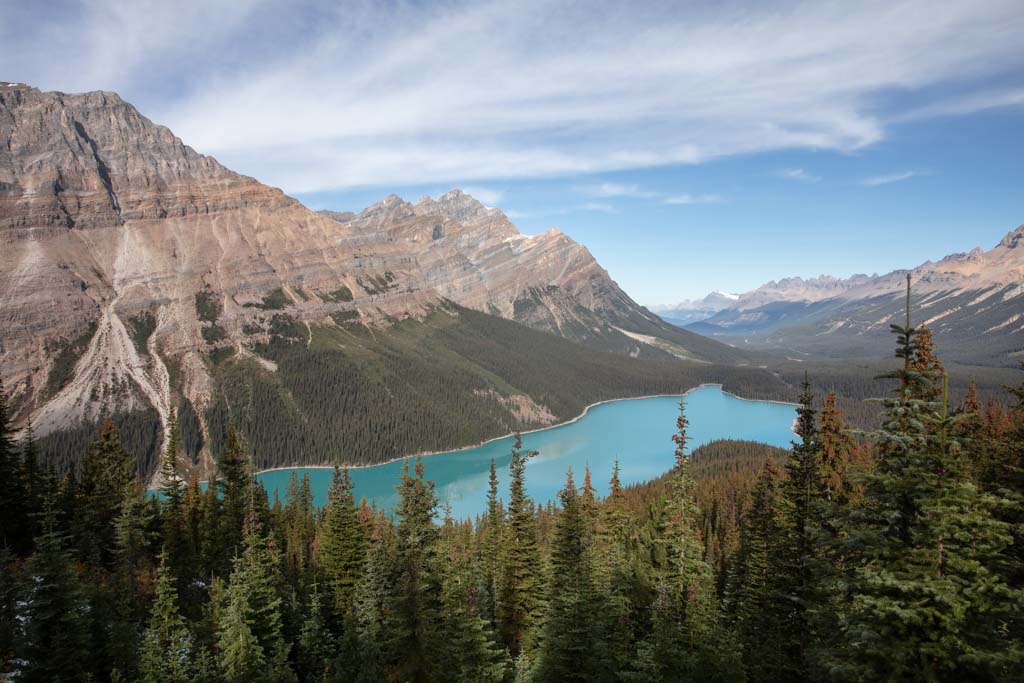
A Guide to Banff National Park
A Guide to Banff National Park was originally published in April 2023
Famous for the dazzling turquoise hues of Lake Louise and Moraine Lake backed by the jagged pinnacles of the Canadian Rockies, paired with the ease of access, it’s simple to see why Banff National Park is Canada’s most-visited national park.
I finally made it to Banff in the fall of 2022, coupled with a visit to neighboring Jasper National Park, as part of my road trip down the Alcan as I made the move from Alaska to Colorado (and now in the spring of 2023, on to Utah)
Need Travel Insurance and Evacuation Services for Canada?
Start shopping for travel insurance plans over at IATI Insurance. Readers of the Adventures of Nicole get a 5% discount off your plan.
The Adventures of Nicole partners with Global Rescue to offer the world’s leading medical evacuation and security advisory services. To travel with peace of mind, shop evacuation coverage at Global Rescue.
- Best Time to Visit Banff National Park
- How Many Days to Spend in Banff
- How to get to Banff National Park
- Entry to Banff National Park
- Getting Around in Banff National Park
- Banff National Park by Tour
- Things to do in Banff National Park
- Hiking in Banff National Park
- Hotels, Hostels & Campgrounds in Banff National Park
- Eating & Dining in Banff National Park
- Other Tips for Visiting Banff National Park
Best Time to Visit Banff National Park
As I mentioned in my Jasper National Park Travel Guide, I visited Banff in late September myself and would say this is a great time to visit as it’s still warm in the daytime hours, overnight temps aren’t too bitterly cold yet, and the crowds have significantly dwindled from the summer season.
In general, it’s best to visit Banff National Park in the summer months of May to September for optimal weather. That said, June-August can be insanely crowded as that time coincides with summer break, so in my opinion that’s a time best avoided. However, if that’s the timeframe you’re working within, make sure to reserve campsites or hotels far in advance.
This brings me to the shoulder months of May, September, and October which are the best months since you still generally have decent weather, and smaller crowds.
Winter months (November-March) are a great time to visit if you don’t mind a little cold and enjoy winter sports. Banff is known for its world-class skiing opportunities.

How Many Days to Spend in Banff
Just like in Jasper, how many days to spend in Banff National Park is highly subjective. Myself, I only had really two days to play with in Banff, so I mainly tried to hit the highlights that I could eek in.
Most visitors spend about 2-3 days in Banff, driving between most of the park’s epic sites. Those that want to take on some of the longer hikes within Banff National Park may need a week or more to visit.
How to get to Banff National Park
Getting to Banff National Park is easy with the options of coming by car, bus, or train.
The nearest international airport to Banff National Park is Calgary International Airport which is located about 90 minutes away by car. Next up is Edmonton International Airport which is situated about 3 and a half hours away by car.
By car
First and foremost, I would recommend renting a car for your visit to Banff (unless you’re visiting as part of a larger road trip as I did and have your own car anyways) to give you the freedom to explore Banff National Park on your terms and on your own timeline.
If coming from Calgary, you’ll most likely arrive in Banff using the Trans-Canada Highway.
If you are arriving from Edmonton and combining your visit to Banff with neighboring Jasper National Park, it makes the most sense to enter Jasper via the Yellowhead Highway at the town of Hinton.
From Jasper Town, you’ll continue along one of the most scenic roads in the world, the Icefields Parkway.
The Icefields Parkway is the main thoroughfare that connects Jasper to Banff.
By Shuttle Bus
Several shuttle bus services connect Calgary International Airport to Banff. This shuttle bus service is reasonably priced, includes free wi-fi, and offers several departures per day between 9 am and 10 pm.
By Train
A great way to visit the Canadian Rockies and take in all the views along the way is to visit by train. Check out this 6-day train tour between Calgary and Vancouver that visits both Jasper and Banff National Park.
Entry to Banff National Park
Banff National Park does have entry fees to visit the park unless you’ve already purchased a Parks Canada yearly Discovery Pass that would include your visit to Banff.
Entry to Banff National Park costs $10.50 CAD per day for adults, $9.00 for seniors (64+), and free for youth (under 18).
Note that your entry fee includes both Jasper and Banff National Parks. Park fees are payable by card or cash at the entry stations into the park.

Getting Around in Banff National Park
The easiest way to get around Banff National Park is by car, so as mentioned earlier, renting a car would be wise.
If ultimate freedom is the goal and you don’t want to rent a car and drive yourself, the next best option would be to hire taxis from Banff Town for drop-offs around the park.
A solid option if you want freedom and don’t want to drive is the Banff Hop On Hop Off Bus to get yourself around Banff’s world-renowned destinations. Roam Transit also offers shuttles between May and September around Banff Town and to a few locations in the park.
For those more intrepid you can opt to pack your bicycle to Banff with you and cycle your way through the park and along the Icefields Parkway.
Banff National Park by Tour
There are countless tours on offer around Banff National Park to fit just about any interest or fitness level.
For those who want to combine a visit to both Banff and Jasper National Parks, there are great options for those that want to visit both parks as a day trip or up to a weeklong tour of Jasper and Banff.
Things to do in Banff National Park
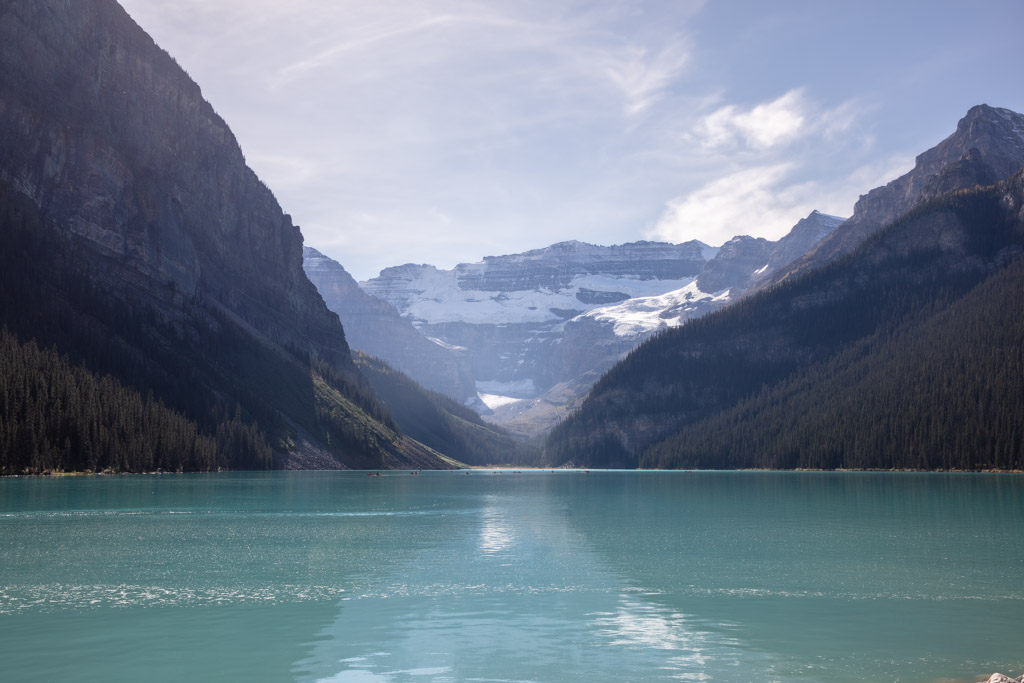
Lake Louise
Glacially fed and impossibly turquoise, Lake Louise is undeniably one of Banff’s must-see destinations and surely Canada’s most famous lake. Whether you stroll the waterfront, kayak the azure blues, or take on one of the many hikes that start from the shore, there’s something for just about everyone at Lake Louise.
If you’re after aerial views of Lake Louise and don’t want to dust off your hiking boots for an upward trek, opt for a ride up the Lake Louise Gondola from Lake Louise Ski Resort.
The views won’t disappoint and you’ll have the opportunity to grab a drink or have a bite to eat at the restaurant up top.
If you don’t mind a splurge, you can book the Fairmont Chateau Lake Louise which is situated right on the shore of the lake.
Moraine Lake
Equally as popular and not too far from Lake Louise is the uber-famous Moraine Lake. Like its neighbor, Moraine Lake is also glacially fed, giving it a neon blue hue.
Get here extra early to ensure you get a parking spot at the lot for Moraine Lake can fill quickly. I got lucky visiting in the early afternoon and eeked in just before the lot shut due to being full.
Those that want to catch the sunrise at Lake Louise should plan to get an early start, especially in the peak season months when photographers start rocking up as early as 1 to 2 am to get their ‘spot’.
I didn’t bother with getting up for sunrise, even with a later September visit, and opted for a nice afternoon visit. Don’t get me wrong, I love a good lake sunrise photo, but I’m spoiled and have had more than my fair share of Tajikistan’s beautiful mountain lakes without the crowds.
Want to take in Banff’s beautiful lakes but don’t want to go at it alone? Check out this well-loved Lake Louise and Moraine Lake day tour.
Sulphur Mountain Gondola
If a bird’s eye view of downtown Banff is what you’re after, a ride up the Sulphur Mountain Gondola is most definitely in order.
The 8 minute ride to the top of Sulphur Mountain gives sweeping views of Banff Town and its surroundings from inside the glass-paneled tram.
At the top, you’ll arrive at the Sanson Peak Boardwalk.
If you’re wanting to get in a nice hike, opt to trek the nearly 11 kilometer path to the top and then reward yourself with a gondola ride back down. The trailhead for the Sulphur Mountain hike is located right next to the gondola entrance.
Cave & Basin Historical Site
If you want to delve further into the history of Banff National Park, then a visit to the Cave and Basin National Historic Site is in order, and although you can visit on your own, going on a guided Cave and Basin National Historic Site tour is recommended to take in the rich history that unfolds here.
The history of Cave and Basin National Historic Site extends back over 10,000 years, though despite this, the site was stumbled upon by three railway workers in 1883, which eventually led to Banff National Park becoming Canada’s very first national park.
The Railway workers first noticed the natural ‘skylight’ that allows the sun’s rays to illuminate the cave’s natural hot spring, which reminded me of some of the cenotes found along Mexico’s Yucatan Peninsula.
Banff National Park is situated on the traditional lands of the three nations of the Blackfoot Confederacy (Pikani, Kainai, and Siksika), and the Stoney Nakoda Nations of Wesley, Bearspaw, and Chinink, and the Dene people.
Peyto Lake
Personally, Peyto Lake was my favorite of all the places I visited along the Icefields Parkway as I traversed both Jasper and Banff National Park.
The gorgeous turquoise lake, shaped like a fox is set in a beautiful emerald evergreen forest.
A short 15-20 minute walk (shorter if you are on a bus tour) along a paved walking trail will bring you up an incline and to the Peyto Lake viewing platform.
But don’t stop there, continue along the spiderweb of trails leading from the viewing platform to get better panoramas of Peyto Lake without the crowds. Just a short walk will yields better aerial views of Peyto Lake and will give you the feeling of having the entire place to yourself after you’ve ditched the masses.
If you want a very different perspective of Peyto Lake, strap on a pair of comfy trainers and make the hike to the Bow Summit Lookout.
If you want to visit Peyto Lake and don’t want to go at it alone, opt for this Icefields Parkway Day tour that includes a visit to Peyto Lake.
Banff Town
In need of a break from the outdoors? Then a visit to Banff Town is in order.
For history buffs and art lovers, Banff Town will be the perfect retreat offering several museums and galleries including the Banff Park Museum, the Buffalo Nations Luxton Museum, the Carter–Ryan Gallery, and the Whyte Museum of the Canadian Rockies.
If history and art aren’t your thing, there are plenty of restaurants and shopping to explore around town.
Ski in Two Provinces at Sunshine Village
Straddling both Alberta’s Banff National Park and British Columbia’s and Mount Assiniboine Provincial Park, Sunshine Village features diverse terrain bolstering its position as a world-class ski resort.
Owing to its unique location, perched atop the Continental Divide high in the Canadian Rockies, Sunshine Village boasts the best and most snow of Banff National Park’s three ski resorts (the other two being Lake Louise Ski Resort and Mount Norquay Ski Resort).
So if it’s a winter trip you’re after, Sunshine Village is a must for skiers and snowboarders.
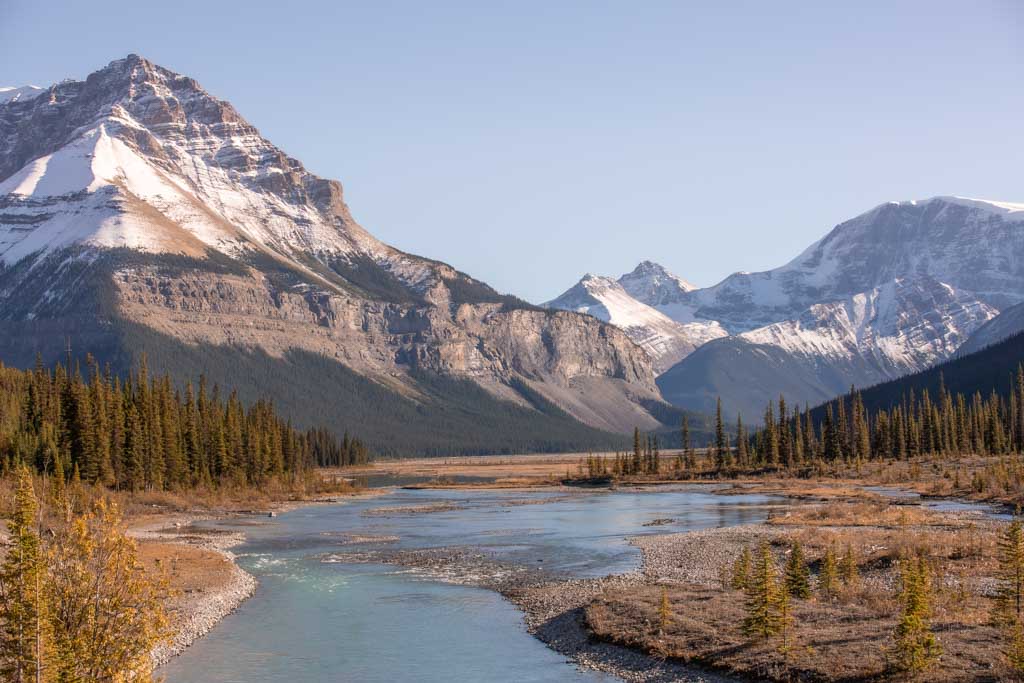
Icefields Parkway Drive
Among the most beautiful scenic road trips in the world, a drive along the Icefields Parkway is an absolute must-do for any visitor to Banff National Park.
The Icefields Parkway meanders through the glacially-carved and jagged Canadian Rockies connecting Jasper and Banff National Parks.
Truth be told, many of Banff’s best sites and best hikes are scattered along the Icefields Parkway, which in my opinion makes no visit to Banff National Park complete if this section of the park is skipped.
Not wanting to road trip the Icefields Parkway on your own? Not to worry, check out this Icefields Parkway day tour to take the hassle out of doing it yourself.
Johnston Canyon
The jumping-off point for several of Banff National Park’s most sought-after hikes including Upper and Lower Falls Trails, and the Ink Pots Trail, Johnston Canyon is a must-visit for any visit to Banff National Park.
If visiting in the winter, consider an ice walk tour to take in the spectacular scenery of ice-glazed Johnston Canyon, though I can’t speak from personal experience as I opted for a September visit. The winter photos I have seen of Johnston Canyon are stunning.
Lake Minnewanka
Translating out to Lake of the Spirits, aptly named by the Nakoda First Nations people, Lake Minnewanka has a history stretching back over 14,000 years.
Take the opportunity to jump on a Lake Minnewanka cruise to learn more about the history and archeological finds of the area or put on your hiking boots and explore the Minnewanka Lakeshore Trail that meanders beyond the lake and up into Stewart Canyon that was carved by the Cascade River.
Mount Norquay Chairlift
For a different perspective of Banff town from above and the opportunity for a drink (or meal) with an epic view from the Cliff House Bistro, the Mount Norquay Chairlift is a great thing to do in Banff National Park.
From the top, you’ll have grand views of Mount Rundle and the Bow River in addition to Banff Town.
if you’re visiting in the winter months, get in some world-class skiing here from the Mount Norquay Resort.
Banff Upper Hot Springs
Sat near the top of Sulphur Mountain, Banff Upper Hot Springs is the only spring open to public bathing in Banff National Park.
The geothermically heated natural mineral hot springs are a great place to relax year-round and especially during those chilly winter months.
Banff Upper Hot Springs’ claim to fame is that it is Canada’s highest-elevation hot spring.
Vermillion Lakes
Easy to access from Banff Town at under 3 kilometers away, the three dazzling Vermillion Lakes are a great option for those not wanting to stray too far from town but still want to get out and explore Banff National Park’s great outdoors.
Keep an eye out and your camera handy for wildlife appearances around Vermillion Lakes.

Hiking in Banff National Park
Easy
- Bow Falls Trail | 3 kilometers | 1-2 hours
- Bow Summit Lookout | 2.9 kilometers | 2.5 hours
- Brewster Glacier Skywalk | 500 meters | 1 hour
- Consolation Lakes Trail | 5.8 kilometers | 2 hours
- Fairview Lookout | 1 kilometer | 45 minutes
- Hoodoos Trail | 9.6 kilometers | 5-6 hours
- Johnston Canyon Upper & Lower Falls | 4.8 kilometers | 1.5 hours
- Karst Spring Trail | 9.5 kilometers | 4-5 hours
- Moraine Lake Lakeshore Trail | 3 kilometers | 45 minutes
- Parker Ridge | 5.4 kilometers | 2.5 hours
- Spray River Loop | 12 kilometers | 4 hours
- Sunshine Meadows | 8 kilometers | 2 hours
- Two Jack Lakes | 4.8 kilometers | 2 hours
Moderate
- Cascade Amphitheatre | 15.5 kilometers | 5-6 hours
- Bourgeau Lake & Harvey Pass | 14.5 kilometers | 5-6 hours
- Chephren Lake | 7 kilometers | 3 hours
- Glacier Lake | 17 kilometers | 6 hours
- Helen Lake Trail | 16.7 kilometers | 4-6 hours
- Ink Pots | 10.8 kilometers | 4 hours
- Lake Agnes Tea House | 6.8 kilometers | 3 hours
- Larch Valley & Minnestimma Lakes | 8.6 kilometers | 4 hours
- Little Beehive | 2 kilometers | 2 hours
- Mount Saint Piran | 14.2 kilometers | 5 hours
- Plain of Six Glaciers | 10.6 kilometers | 4 hours
- Redeath Creek to Shadow Lake | 14.5 kilometers | 4-5 hours
- Stanley Glacier Trail | 10.5 kilometers | 3 hours
- Sulphur Mountain | 5.5 kilometers | 4 hours
- Tunnel Mountain | 4.8 kilometers | 1-2 hours
- Wapta Icefield Hike | 13 kilometers | 3-4 hours
- Wilcox Pass | 8 kilometers | 3-4 hours
Difficult
- Aylmer Lookout | 23 kilometers | 8 hours
- Big Beehive | 3.2 kilometers | 2 hours
- Centennial Ridge Trail | 16 kilometers | 10 hours
- Cory Pass & Mount Edith Circuit | 13 kilometers | 5-6 hours
- Mount Assiniboine | 30 kilometers | 13-15 hours
- Mount Rundle | 11 kilometers | 7-8 hours
- Rockbound Lake | 17.9 kilometers | 7-9 hours
Hotels, Hostels & Campgrounds in Banff National Park
There are accommodation options to fit nearly every budget range within Banff National Park.
Campgrounds
Myself, I opted to camp my way through Banff and Jasper National Parks as I traveled through Canada down from Alaska to help keep my costs down (plus I just really like camping).
There are numerous campgrounds located throughout Banff National Park. Some are on a first-come-first-serve basis, while the majority are reservable online.
Parks Canada manages the campgrounds within Banff National Park. See the full list of campgrounds in Banff to explore your options.
Hostels
There are a few hostels scattered around Banff National Park that can be good options for solo backpackers, though expect prices to still be a bit spendy as Banff is Canada’s premier national park.
Hostels to check out include:
- Banff International Hostel
- HI Banff Alpine Center
- HI Castle Mountain Hostel
- HI Lake Louise Alpine Center
- HI Mosquito Creek Hostel
- HI Rampart Creek Hostel
- Samesun Banff
Budget Couples & Groups
Hostel dorms may not be the most budget-friendly option for those traveling in groups of two or more. If this is the case, you may get a better deal if booking a double/triple, etc. room.
vBudget hotels to scan prices:
Midrange
Midrange travelers visiting Banff National Park will have more options than their budget counterparts. That said, do expect midrange prices to be a bit high, it is Banff after all.
Midrange
Luxury
Luxury travelers are in luck visiting Banff National Park as there are a plethora of high-end hotels, resorts, and lodges to choose from. As Banff is a bucketlister, expect the prices to reflect its demand.
Splurge
Eating & Dining in Banff National Park
This post is getting quite long so I am going to leave you to your own devices regarding eating and dining in Banff National Park.
In general, expect inflated prices whether you plan to shop in grocery stores and eat and prepare your own meals or if you plan to dine out. You’re in a national park after all, and one of the most popular in Canada and the world.
For budget travelers, it would be advisable to stick your cooler and snack kit in either Calgary or Edmonton, long before reaching the park to ensure you’re getting the lowest prices on your food.
For dining out, Banff offers an array of options from Cheap (relatively, considering where you’re at) to world-class high-end restaurants.
Other Tips for Visiting Banff National Park
- Bringing bear spray with you (I’d recommend picking some up in Calgary on your way to Banff) is advisable.
- If planning to do day hikes or overnighters, a bear vault is recommended to make food odors.
- Always keep your distance from wildlife.
- Dress in layers. I found Banff National Park to be a little warmer than Jasper. That said, the weather can be erratic.
Have any questions about visiting Banff National Park?
Ask in the comments sections below.
